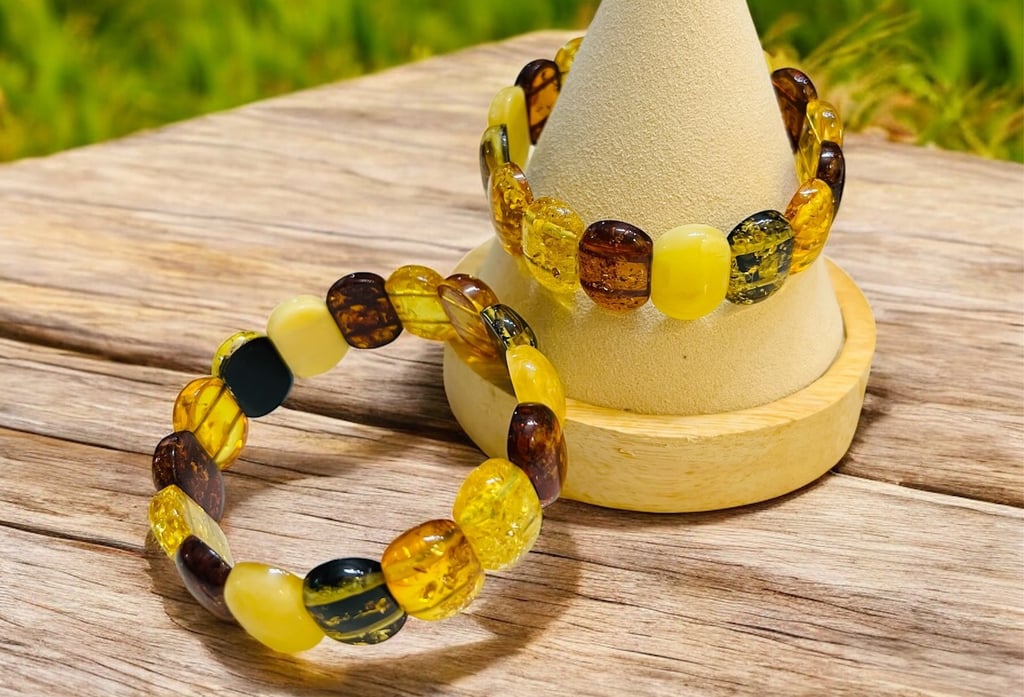The Allure of Amber: Nature's Gemstone
Amber is a remarkable natural substance that has intrigued humanity for thousands of years. Formed from the fossilized resin of ancient trees, amber ranges in color from golden yellow to deep brown, with even greenish hues.


The Formation of Amber
Amber, often regarded as nature's gemstone, originates from the resin of ancient coniferous trees. The process begins when these trees secrete resin as a defense mechanism against injury or disease. Over millions of years, this organic material undergoes a remarkable transformation, transitioning from a sticky, viscous substance to a solid, fossilized form known as amber.
The Beauty of Amber: A Visual Delight
Color variations in amber can be attributed to several factors, including the specific type of tree from which the resin was derived, the geographical location, and the storage conditions over millions of years. The molecular structure of the resin influences its color, resulting in hues ranging from the traditional golden yellow to darker shades of brown and even rare green and blue ambers.
Moreover, the presence of other minerals during the fossilization process may lead to the formation of distinct colors and patterns within the amber, enhancing its allure and uniqueness. The enchanting qualities of amber are not merely aesthetic; they also provide a window into the ancient realms of Earth's history.
One of the most remarkable features of amber is its translucency. Unlike many gemstones that may possess an opaque quality, amber allows light to filter through its structure, creating a stunning warm glow that enhances its natural beauty. The interplay of light within the stone can reveal layers and depth, drawing the observer in and creating an enchanting visual experience. This attribute makes amber highly desirable for artisans, as it lends itself beautifully to intricate designs and showcases the craftsmanship involved in creating jewelry or art pieces.
Cultural Significance of Amber
One of the earliest known uses of amber was as a trading commodity; it was highly valued in the Baltic region and facilitated long-distance trade routes with distant cultures, including the Romans and Greeks.
In ancient Rome, amber was associated with the sun and believed to hold protective powers. Roman jewelers crafted intricate designs using amber, showcasing its appeal as a decorative element in jewelry and ornaments. Similarly, in various Indigenous cultures, amber was often used in ceremonial items, symbolizing healing and protection. The belief in amber's capacity to ward off evil spirits can be found in folklore across different cultures, where it was routinely incorporated into rituals and amulets.
Amber also holds a prominent place in mythology and legend. In Greek mythology, for instance, the tears of the sun and the nymphs were said to transform into amber, signifying the connection between the celestial and earthly realms.
Through its historical utilization in trade, mythology, and artistry, amber remains a testament to human creativity and cultural significance across ages. Its enduring allure continues to captivate people, making it not just a beautiful gemstone but also a potent symbol of heritage and legacy.
Health Benefits and Therapeutic Properties
Amber, often regarded as a gemstone of warmth, boasts a rich history of purported health benefits and therapeutic properties. Traditionally, this fossilized tree resin has been used in various cultures for its believed healing qualities. Among the most notable claims is amber's role in pain relief. Many advocate that wearing amber, especially in the form of jewelry, can help alleviate discomfort associated with teething in infants, as well as reduce inflammation and pain in adults. This is largely attributed to the presence of succinic acid, a compound thought to have analgesic and anti-inflammatory properties.
In addition to pain relief, amber is often lauded for its potential to reduce stress and promote emotional well-being. It is believed that the natural elements in amber possess a calming effect on the mind and body, which can help individuals achieve a more balanced emotional state.
A burgeoning interest in alternative medicine has also placed amber into the spotlight as a holistic remedy. Practitioners may incorporate amber into their healing practices, citing its resonant energy as beneficial for various ailments. This energy is often described as grounding, assisting individuals in reconnecting with their inner selves while fostering a sense of connection to nature.
Choosing and Caring for Amber Jewelry
When it comes to selecting quality amber jewelry, understanding the characteristics that define authentic amber is essential. Authentic amber is fossilized tree resin, typically originating from coniferous trees. The most valuable pieces often exhibit a warm, golden hue, although amber can also range in color from yellow to deep walnut. One way to ensure you are purchasing real amber is to perform a simple test: immerse the piece in saltwater. Genuine amber will float, while imitations or resin will sink.
While inspecting an amber piece, be mindful of its clarity and inclusions. Natural amber may contain trapped air bubbles or plant material, which can enhance its beauty and value. The surface texture should also be smooth without obvious scratches or blemishes, indicating that it has been crafted with care.
To store amber jewelry effectively, keep it in a soft pouch or lined box, ensuring it does not come into contact with harder metals or stones that could scratch it. Additionally, avoid exposing amber to direct sunlight for prolonged periods, as this can lead to fading in color. With these guidelines in mind, you can ensure that your amber jewelry retains its charm and allure for years to come.
Embracing the Natural Beauty of Amber
Amber, with its mesmerizing hues and intriguing inclusions, serves as a remarkable reminder of nature's artistry. This unique gemstone, forged over millions of years from fossilized tree resin, is not merely a decorative item; it embodies a rich cultural history and a host of personal benefits that merit our appreciation and respect.
